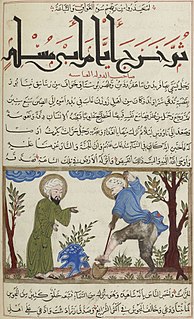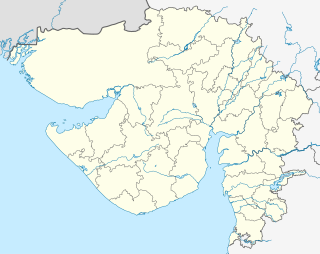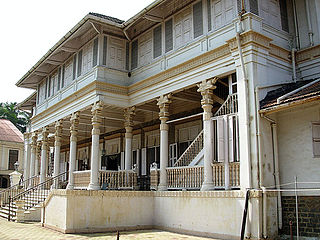
Zoroastrianism or Mazdayasna is one of the world's oldest continuously practiced religions, based on the teachings of the Iranian-speaking prophet Zoroaster. Zoroastrianism has a dualistic cosmology of good and evil and an eschatology which predicts the ultimate conquest of evil by good. Zoroastrianism exalts an uncreated and benevolent deity of wisdom, Ahura Mazda, as its supreme being. The unique historical features of Zoroastrianism, such as its monotheism, messianism, judgment after death, heaven and hell, and free will may have influenced other religious and philosophical systems, including Second Temple Judaism, Gnosticism, Greek philosophy, Christianity, Islam, the Baháʼí Faith.

Zoroaster, also known as Zarathustra, Zarathushtra Spitama or Ashu Zarathushtra, was an ancient Iranian prophet who founded what is now known as Zoroastrianism. His teachings challenged the existing traditions of the Indo-Iranian religion and inaugurated a movement that eventually became the dominant religion in Ancient Persia. He was a native speaker of Old Avestan and lived in the eastern part of the Iranian Plateau, but his exact birthplace is uncertain.
The Iranian calendars or Iranian chronology are a succession of calendars invented or used for over two millennia in Iran, also known as Persia. One of the longest chronological records in human history, the Iranian calendar has been modified time and again during its history to suit administrative, climatic, and religious purposes. The most influential face in laying the frameworks for the calendar and its precision was the 11 century Persian polymath, hakim Omar Khayyam. The modern Iranian calendar is currently the official calendar in Iran. It begins at the midnight nearest to the instant of the vernal equinox as determined by astronomic calculations for the Iran Standard Time meridian. It is, therefore, an observation-based calendar, unlike the Gregorian, which is rule-based.

Atar, Atash, or Azar is the Zoroastrian concept of holy fire, sometimes described in abstract terms as "burning and unburning fire" or "visible and invisible fire". It is considered to be the visible presence of Ahura Mazda and his Asha through the eponymous Yazata. The rituals for purifying a fire are performed 1,128 times a year.
Iranian religions are religions which originated in Greater Iran.

Behāfarīd was an 8th-century Persian Zoroastrian heresiarch who started a religious peasant revolt with elements from Zoroastrianism and Islam. He believed in Zoroaster and upheld all Zoroastrian institutions. His followers prayed seven times a day facing the sun, prohibited intoxicants, and kept their hair long and disallowed sacrifices of cattle except when they were decrepit. His revolt was quelled by the Abbasid general Abu Muslim, and he was executed by hanging. His followers, however, believed that he would descend again. Some of his followers joined the Ustadh Sis movement.

Vishtaspa is the Avestan-language name of a figure of Zoroastrian scripture and tradition, portrayed as an early follower of Zoroaster, and his patron, and instrumental in the diffusion of the prophet's message. Although Vishtaspa is not epigraphically attested, he is – like Zoroaster – traditionally assumed to have been a historical figure, although obscured by accretions from legend and myth.

Zurvanism is a hypothetical religious movement of Zoroastrianism in which the divinity Zurvan is a First Principle who engendered equal-but-opposite twins, Ahura Mazda and Angra Mainyu. Zurvanism is also known as "Zurvanite Zoroastrianism", and may be contrasted with Mazdaism.

The Dēnkard or Dēnkart is a 10th-century compendium of Zoroastrian beliefs and customs during the time. The Denkard is to a great extent considered an "Encyclopedia of Mazdaism" and is a valuable source of information on the religion especially during its Middle Persian iteration. The Denkard, however, is not generally considered a sacred text by a majority of Zoroastrians but is still considered worthy of study.

A fire temple, Agiary, Atashkadeh, Atashgah (آتشگاه) or Dar-e Mehr is the place of worship for the followers of Zoroastrianism, the ancient religion of Iran (Persia). In the Zoroastrian religion, fire, together with clean water, are agents of ritual purity. Clean, white "ash for the purification ceremonies [is] regarded as the basis of ritual life", which "are essentially the rites proper to the tending of a domestic fire, for the temple [fire] is that of the hearth fire raised to a new solemnity". For, one "who sacrifices unto fire with fuel in his hand ..., is given happiness".

Zoroastrians are the oldest remaining religious community in Iran. Prior to the Muslim conquest of Iran, Zoroastrianism was the primary religion of the Sassanid Iran.
Zoroastrianism in Azerbaijan goes back to the first millennium BC or earlier and was the predominant religion of Greater Iran before the conversion to Islam.

Udvada is a town situated in Pardi taluka in the Valsad district in the state of Gujarat, India. Udvada is a coastal town located around 24 km from the Valsad city. The Zoroastrian temple, Udvada Atash Behram is situated here.

Zoroastrianism has numerous festivals and holy days, all of which are bound to the Zoroastrian calendar. The Shahenshahi and Kadmi variants of the calendar do not intercalate leap years and hence the day of the Gregorian calendar year on which these days are celebrated shifts ahead with time. The third variant of the Zoroastrian calendar, known as either Fasli or Bastani, intercalcates according to Gregorian calendar rules and thus remains synchronous with the seasons. For details on the differences, see Zoroastrian calendar.

Amerdad is the Avestan language name of the Zoroastrian divinity/divine concept of immortality. Amerdad is the Amesha Spenta of long life on earth and perpetuality in the hereafter.
The Yasna Haptanghaiti, Avestan for "Worship in Seven Chapters," is a set of seven hymns within the greater Yasna collection, that is, within the primary liturgical texts of the Zoroastrian Avesta. Chapter and verse pointers are to Yasna 35-41. The name is from Yasna 42, a Younger Avestan text that follows the seven chapters.
Zartosht Bahram e Pazhdo, was a significant Persian Zoroastrian poet and the son of Bahram-e-Pazhdo. He was born in the early or mid 13th century.
An Atash Behram is the highest grade of a fire that can be placed in a Zoroastrian fire temple as an eternal flame, the other two lower graded fires are Atash Adaran and below Adaran is the Atash Dadgah- these three grades signify the degree of reverence and dignity these are held in. The establishment and consecration of the Atash Behram fire is the most elaborate of all the grades of fire. It involves the gathering of 16 different types of fire, including lightning, fire from a cremation pyre, fire from trades where a furnace is operated, and fires from the hearths as is also the case for the Atash Adaran. Each of the 16 fires is then subject to a purification ritual before it joins the others. A large team of priests are required for the purification and consecration ceremonies, which can take up to a year to complete.

The Zand-i Wahman Yasn is a medieval Zoroastrian apocalyptical text in Middle Persian. It professes to be a prophetical work, in which Ahura Mazda gives Zoroaster an account of what was to happen to the behdin and their religion in the future. The oldest surviving manuscript is from about 1400, but the text itself is older, written and edited over the course of several generations.

The Iranshah Atash Behram, also known as the Udwada Atash Behram is a sacred fire housed in a temple in Udvada, Gujarat on the west coast of India. It is the first of the eight fire temples of the Zoroastrian religion in the country. The Atash Bahram, meaning "Victorious Fire", is the oldest fire temple in India, dated to the eighth century, and represents the historical cultural and religious links with Iran. The current temple housing the sacred fire was built in 1742 by Motlibai Wadia from Bombay. The temple structure, built spaciously, is well decorated and contains the Dasturji Kaiyoji Mirza hall and a museum. The main hall of the temple is accessed through a two-stage staircase. The temple attracts Zoroastrian pilgrims from all parts of India, Pakistan, and from around the world.





